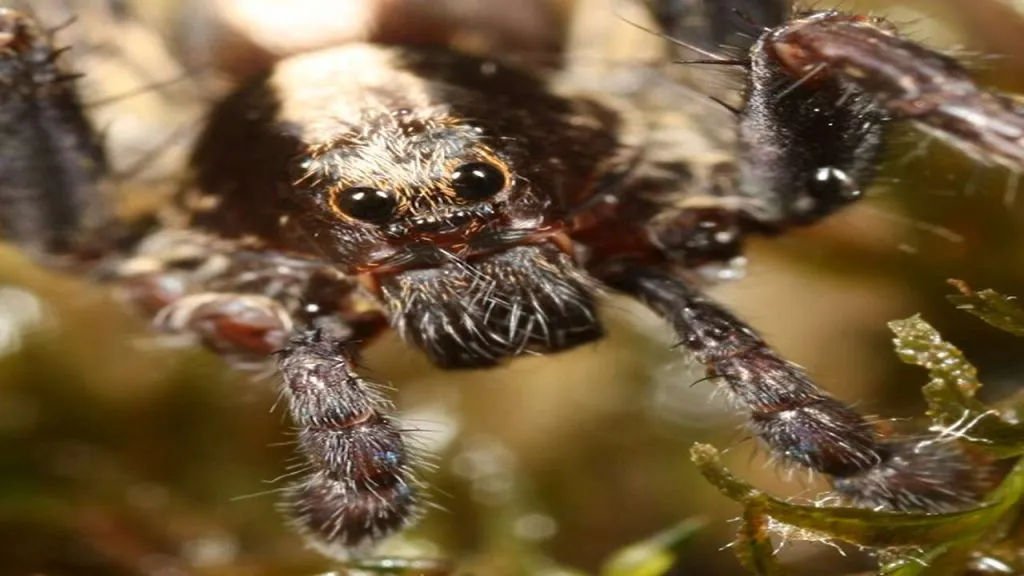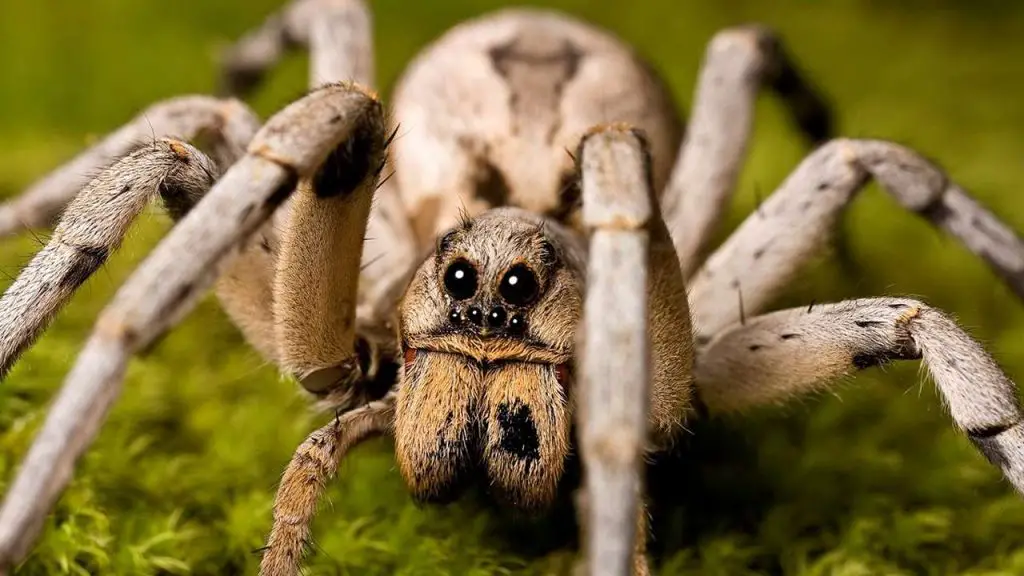As an Amazon Associate I earn from qualifying purchases.
Wolf spiders are generally not mean, and they only bite if they feel threatened.
Their bites usually don’t hurt people much, but they might cause a bit of pain, swelling, and redness.
You can find wolf spiders in lots of different places all around the world, especially where there are a bunch of plants, like forests, fields, and gardens.
These spiders are night owls—they hunt at night and eat small bugs and other little creatures.
They’re usually pretty shy and will stay away from people if they can. If you happen to see one, it’s best to stay calm and not bother it.
Some folks think wolf spiders are scary, but they’re helpful to us because they eat harmful bugs. If you spot one in your house, it’s best to just let it be and do its thing.
Even though they might look scary, learning about what wolf spiders eat helps us understand why they’re important and can help us not be scared of them.
This article will discuss all about what wolf spiders eat, including Arctic ones, and even their cool hunting tricks and interesting facts.
What Do Wolf Spiders Eat: Food They Love To Eat

Wolf spiders, which are part of the Lycosidae family, are meat-eating hunters with a diverse diet. They mainly eat small insects and other bugs.
These spiders are good at hunting and can catch lots of different kinds of prey, like ants, beetles, grasshoppers, crickets, flies, moths, and mosquitoes.
Even though they’re spiders themselves, they’ll eat other spiders too, along with other arachnids like harvestmen, and different kinds of centipedes and millipedes.
Sometimes, the bigger wolf spiders might even go after small frogs, lizards, or snakes if they think they can handle it.
They also target the larvae of insects, like caterpillars, and beetles, as well as tiny creatures like springtails, mites, and small snails that live where they do.
What do Baby Wolf Spiders Eat?
Young wolf spiders, like their grown-up counterparts, are meat-eaters. They hunt down small insects like fruit flies, springtails, tiny flies, and microscopic worms.
These critters make up the main part of their diet. Interestingly, while adult wolf spiders actively go after their prey, the baby spiders rely on their mom for food after they hatch.
The mother spider might throw up partially digested food to feed her babies during this time.
As the spiderlings get bigger and better at hunting, they start going after larger prey like gnats, aphids, and small moth larvae.
It’s important to note that, unlike adult spiders, baby wolf spiders don’t need to eat as often. They can go up to five days between meals.
What do Arctic Wolf Spiders Eat?
Arctic wolf spiders, just like their cousins in warmer places, are meat-eaters, but they have fewer options because it’s so cold where they live.
They mainly eat springtails, these tiny bugs without wings that are all over the Arctic. Springtails are important because they eat fungi, which helps break down dead plants.
But there’s a problem brewing because the Arctic is getting warmer. As it heats up, there might be fewer springtails around.
This could mess up the whole balance of things in the Arctic.
Besides springtails, these spiders also grab whatever other small bugs they can find, like flies, mosquitoes, and beetles.
They’re tough little guys, able to handle the cold, so they make do with whatever food they can find to survive in their icy home.
What do Desert Wolf Spiders Eat?
In contrast, Desert Wolf Spiders, which live in dry areas, have adapted to survive in tough conditions by eating different kinds of bugs found in deserts.
Unlike Arctic wolf spiders, which live in cold places, desert wolf spiders have a different menu of prey.
This includes beetles of various sizes and types, depending on the specific desert they inhabit.
Desert ants are also a common and nutritious food source for these spiders, and if there are termites around, they become potential meals too.
Like Arctic wolf spiders, desert ones will catch any small insect.
Despite the lack of plants and the tough environment, desert wolf spiders are skilled hunters and can find food in the desert.
It’s interesting to note that both Arctic and desert wolf spiders might eat each other, especially when there’s not much other food around or when bigger adult spiders come across smaller ones.
How do Wolf Spiders Hunt Their Prey?

Unlike spiders that build webs, wolf spiders hunt actively for their food. They get their name from how they stalk and chase their prey.
Wolf spiders have excellent eyesight, especially with their two big eyes facing forward, helping them spot potential meals from far away.
Some of these spiders are really fast runners, chasing after their prey with quick moves, while others prefer to wait quietly for the perfect moment to attack, often hiding in holes.
When they’re close enough, wolf spiders jump on their unsuspecting prey super fast, using their strong legs to catch and control the insect.
They paralyze their meal with a bite full of venom from their fangs, turning its insides into liquid that they can eat.
Wolf Spider Facts
- They Hunt Instead of Building Webs: Unlike many spiders you know, wolf spiders don’t make webs to catch their food. They prefer to actively search and chase after their prey.
- Good Eyesight: Wolf spiders have eight eyes, and their two big ones in front give them super good vision. They can spot potential food from far away.
- Quick and Agile: These spiders are speedy runners, especially considering their size. They can also hop short distances to catch their dinner.
- Sensitive Touch: Wolf spiders have tiny hairs on their legs that help them feel what’s around them. These hairs are so sensitive they can even detect vibrations, helping them find hidden prey.
- They Carry Their Babies: Mama wolf spiders are great moms. They carry their eggs in a sac on their body until they hatch.
- They’re Everywhere Except Antarctica: There are more than 2,000 types of wolf spiders found all over the world, except in Antarctica. They can live in lots of different places, like fields, forests, deserts, and even your backyard.
- Their Bite Isn’t Dangerous: Wolf spider bites can hurt, but they’re not harmful to humans. They usually only bite if they’re scared.
- Sometimes They Pretend to be Dead: If a wolf spider feels trapped, it might act like it’s dead to trick its predator.
- They Can Be Cannibals: Some wolf spiders will eat other spiders, even ones from their own family if they’re smaller.
Conclusion
As you can see wolf spiders are hunters who seize the chance to eat whatever they can grab.
If you encounter one, it’s crucial to stay calm and not upset. While some might fear wolf spiders, they’re usually not harmful.
They rarely bite unless they feel in danger, and their venom isn’t usually strong enough to hurt people badly.
But for some folks, the venom could cause an allergic reaction. So, if you get bitten, it’s smart to get medical help just to be safe.
FAQ’s:
Wolf spiders don’t experience feelings like hate, but they tend to stay away from areas that are too wet or have lots of other animals that might try to eat them.
Research shows that wolf spiders dislike the smell of some essential oils and herbs like peppermint, cedarwood, citrus, and tea tree oil These smells can bother their sensitive sense of smell.
The biggest wolf spider species can have a body length of up to around 2 inches, but the exact size can vary depending on the species.
Wolf spiders are typically most active during the warmer months of spring and summer when there’s more food around.
However, they can be active year-round in milder climates.
The number of eggs a wolf spider lays can vary depending on the species and the individual, but they can lay anywhere from dozens to several hundred eggs in a single sac.
Amazon and the Amazon logo are trademarks of Amazon.com, Inc, or its affiliates.

